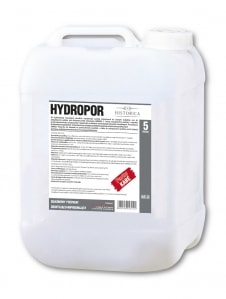HYDROPOR

Priming and impregnating product for mineral substrates and under silicone facade paints
Modern, colourless product based on small-particle, dilutable acrylic and silicone resins. Intended for impregnating all mineral construction substrates outside buildings and for proper preparation of substrates under ARMASIL F silicone facade paint. Suitable for hydrophobic impregnation of concrete substrates, lime renders, cement-lime renders and cement renders, cement and fibre boards, walls made of clinker bricks, face bricks, silicate bricks, linings made of sandstone and mineral paint coatings. To be also applied for priming of mineral substrates (such as concrete, traditional lime renders, cement-lime renders and cement renders as well as thin coat mineral renders) and also substrates covered with polymer-based paint coating.
Note: The product to not be applied on the surfaces of floor toppings or for protecting substrates from ground moisture, surface waters or water under pressure.
| Base binder: | silicone and acrylic binder; |
| The content of volatile organic compounds VOC: | cat. A/h. The product contains less than 30 g/l VOC; |
| Density: | ca. 1.05 g/cm³; |
| Solids content: | ca. 10%; |
| Colours: | colourless; |
| Average coverage: | ca. 0.18-0.20 l/m² (depending on the substrate water absorption); |
| Temperature of application (air and substrate): | from +5°C to +25°C; |
| Relative humidity: | ≤75%; |
| Packaging: | Single-use plastic packaging of 5 and 10 l; |
| Storage: | The product should be stored in its sealed packaging in a cool, but frost-protected room. Opened packaging should be tightly closed and used as quickly as possible. |
| Shelf life: | Originally sealed products have a 12-month shelf life from the date of production (this is printed on the side of the packaging). |
– Improves coating adhesion
– Reduces and equalises substrate water absorption
– Protects from stains and efflorescences
– Makes up a micro-porous coat which allows for free wall ‘breathing’
– Has very high penetrating and substrate strengthening properties
– Reduces dustiness
– Does not change the substrate colour
– Features a very high adhesion to both mineral substrates and polymer coatings
SUBSTRATE PREPARATION: Apply to a sound/stable and clean substrate (without cracks and delaminations), degreased, dry, and free of biological contamination or chemical efflorescence. In case of algae/fungi growth, the substrate
should be cleaned mechanically and then wash with water and disinfect with ALGIZID. Any loose layers not bound to the substrate (i.e. loose render or flaked coatings) should be removed. Old and/or dirty substrates should be washed off and degreased with water and CLEANFORCE cleaning agent. For uneven substrates, first use levelling compound and then level out the surface with the KOMBI FINISZ levelling/finish render. Small unevenness can be levelled out at once with KOMBI FINISZ levelling/finish render. Absorbent substrates should be primed before finish levelling and smoothing compound and/or levelling compound is applied. Please note: if product is applied on new mineral substrates (such as concrete, lime render, lime-cement renders, cement render), 2-week curing period is required.
PRODUCT PREPARATION: The packaging contains ready-to-use product. Do not dilute.
APPLICATION: The product to be applied on the substrate with the use of a paint brush, roller or spraying. Very absorbent substrates should be impregnated twice by means of a ‘wet on wet’ method.
DRYING: Before applying paint, one layer of the product used on the substrate requires curing of ca. 12 hours. Protect the newly made coating against precipitation and condensation until it dries completely. Note: Full hydrophobic properties are achieved after 7 days.
USEFUL HINTS: To be applied on dry days with temperatures above +5°C. Drying time may be longer due to low temperatures and high relative humidity. If this is the case, it is necessary to wait until the primer dries out completely before applying the paint. All tools should be cleaned with water after work is completed. Application during direct exposure to sunlight or in strong winds is not recommended.

 HYDROPOR - TDS
HYDROPOR - TDS